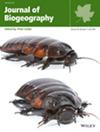Biotic Assembly of the Species of Triatomini (Hemiptera: Reduviidae: Triatominae) in the Mexican and South American Transition Zones
Abstract
Aim
To infer the biogeographic history of the Triatomini by evaluating how their species became part of the biogeographic transition zones of the New World. This group of blood-feeding insects includes key vectors of Chagas disease. Understanding their dispersal and diversification over geological time may help elucidate the temporal dynamics of faunal assembly during the colonisation of different areas across the continent.
Location
Americas.
Taxon
Triatomini kissing bugs.
Methods
We analysed 70 published UCE data of 55 Triatomini terminals, which belong to 39 of its 113 described species. We conducted partitioned ML analyses to reconstruct the phylogenetic relationships within the group. We then estimated the divergence times using one fossil calibration point. With the resulting chronogram, we inferred the ancestral geographic ranges associated with internal nodes of the phylogeny using BBM and BAYAREALIKE + J models.
Results
The most likely ancestral range for the crown node of Triatomini is the Neotropical–South American + South American Transition Zone (SATZ), suggesting that the tribe originated as part of the South American biota during the Oligocene–Miocene, in temporal association with the orogenic uplift of the Andes. A single dispersal to North America was inferred during the Miocene, initially reaching Mesoamerica and subsequently expanding into the Mexican Transition Zone (MTZ) and the Nearctic region, at a time when the Mexican Plateau had reached an advanced stage of geological evolution.
Main Conclusion
Our study challenges the expectations derived from the cenocron framework proposed for the Mexican Transition Zone, which assumes multiple independent colonisation events. Instead, our results are more consistent with an Ancient Neotropical distribution pattern, in which South American ancestors reached the MTZ during the Oligocene–Miocene through a single dispersal process that contributed to the current faunal assembly.


 求助内容:
求助内容: 应助结果提醒方式:
应助结果提醒方式:


